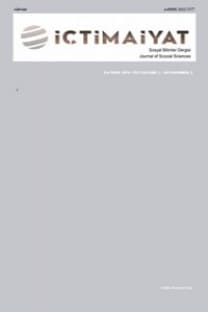Entegrasyon, Asimilasyon ve Uyum Kavramları Arasından Türkiye’nin Seçimi
Göç, Sosyal Uyum, Entegrasyon, Asimilasyon, Strateji
Of The Integration, Assimilation and Social Cohesion Terms, Turkey’s Choice
Migration, Social Cohesion, İntegration, Strategy,
___
- Abadan-Unat, N. (2017). Bitmeyen göç: Konuk işçilikten ulus-ötesi yurttaşlığa (3. baskı). İstanbul Bilgi Üniversitesi yayınları: Vol. 1. Şişli İstanbul: İstanbul Bilgi Üniversitesi Yayınları.
- Adıgüzel, Y. (2016). Göçmenlerin Kültürel Entegrasyonu. In A. Esen & M. Duman (Eds.), Türkiye'de geçici koruma altındaki Suriyeliler: Tespitler ve öneriler (pp. 171–194). İstanbul: Dünya Yerel Yönetim ve Demokrasi Akademisi Vakfı.
- Ager, A., & Strang, A. (2008). Understanding Integration: A Conceptual Framework. Journal of Refugee Studies, 21(2), 166–191. https://doi.org/10.1093/jrs/fen016
- Ahlén, A., & Boräng, F. (2018). Immigration Control in Disguise? Civic Integration Policies and Immigrant Admission. Nordic Journal of Migration Research, 8(1), 3. https://doi.org/10.1515/njmr-2018-0004
- Bartram, D., Poros, M. V., & Monforte (2017). Göç Meselesinde Temel Kavramlar (I. A. Tuncay, Trans.). Ankara: Hece Yayınları. https://dep.manas.edu.kg/img/files/11/Bartram%20D.%20G%C3%B6%C3%A7%20Meselesinde%20Temel%20Kavramlar%202017.pdf
- Beaud, S., & Noiriel, G. (1990). Penser «l'intégration » des Immigrés. Hommes Et Migrations, 1133(1), 43–53. https://doi.org/10.3406/homig.1990.1487
- Berry, J. W. (1991). Understanding and Managing Multiculturalism: Some Possible Implica tions of Research in Canada. Psychology and Developing Societies, 3(1), 17–49.
- Berry, J. W. (1992). Acculturation and Adaptation in a New Society. International Migration, 30, 69–85.
- Berry, J. W. (1997). Lead Article - Immigration, Acculturation, and Adaptation. Applied Psychology, 46(1), 5–34.
- Biology Articles, Tutorials & Dictionary Online (2019). Integration. https://www.biologyonline.com/dictionary/integration
- Bosswick, W., & Heckmann, F. (2007). Integration of Migrants: Contribution of local and regional authorities. Retrieved from
- European Foundation for Improvement of Living and Working Conditions website: https://www.eurofound.europa.eu/sites/default/files/ef_publication/field_ef_document/ef0622en.pdf
- Canbey-Ozguler, V. (2018). Göç ve Uyum Politikaları. (1), 1–18. https://dergipark.org.tr/tr/download/article-file/680300
- Carrera, S. (2006). A Comparison of Integration Programmes in the EU. https://www.files.ethz.ch/isn/20627/Comparison_Integration_Programs.pdf
- Castles, S. (2010). Understanding Global Migration: A Social Transformation Perspective. Journal of Ethnic and Migration Studies, 36(10), 1565–1586. https://doi.org/10.1080/1369183X.2010.489381
- Castles, S., Korac, M., Vasta, E., & Vertovec, S. (2002). Integration: Mapping the Field (Home Office Immigration Research and Statistics Servise).
- Demirava, N. (2021). Briefing-Immigration-Diversity-and-Social-Cohesion (Oxford University). www.migrationobservatory.ox.ac.uk
- ECRE (2005). Towards the Integration of Refugees in Europe.
- Erdoğan, M. M. (2020). Suriyeliler Barometresi 2019. Orion Kitabevi.
- Erkal, M. E. (1998). Social Integration. https://dergipark.org.tr/tr/download/article-file/101068
- Esser, H. (2006). Migration, Language and Integration. AKI (Social Science Research Center).
- Faist, T. (2018). A Primer on Social Integration: Participation and Social Cohesion in the Global Compacts (No. 161). Bielefeld: COMCAD Working Papers.
- Favell, A. (Ed.) (2014). ECPR essays. Immigration, Integration and Mobility: New Agendas in Migration Studies Essays 1998-2014. Colchester: ECPR Press.
- Garcés-Mascareñas, B., & Penninx, R. (Eds.) (2016). IMISCOE research series. Integration Processes and Policies in Europe: Contexts, Levels and Actors / Blanca Garcés-Mascareñas, Rinus Penninx, editors. Cham: Springer Open.
- Goodman, S. W. (2009). Civic Integration Requirements and The Transfotmation of Citizenshiip. Georgetown Universty.
- Güler, H. (2020). Göç ve Entegrasyon: Türkiye'de "Uyum" ama Nasıl? Kafkas Üniversitesi İktisadi Ve İdari Bilimler Fakültesi Dergisi, 11(Ek Sayı-1), 245–268.
- Heckmann, F. (2006). Integration and Integration Policies.
- Kümbetoğlu, B. (2016). Göç Çalışmalarında "Nasıl" Sorusu. Küreselleşme Çağında Göç Kavramlar, Tartışmalar. (3. Baskı). İstanbul: İletişim Yayınları.
- Kymlicka, W. (2013). Çok Kültürlülük: Başarı, Başarısızlık ve Gelecek (F. Öztürk, Trans.), 70(2). https://dergipark.org.tr/tr/download/article-file/97742
- Lockwood, D. (1964). Social Integration and System Integration. In G. K. Zollschan & W. Hirsch (Eds.), Social Change: Explorations, Diagnoses and Conjectures (pp. 370–383). Schenkman Publishing Company.
- Park, R. E., & Burgess, E. W. (2017). Asimilasyon ve Sosyal Kontrol: Sosyoloji Bilimine Giriş II (Pınar Sayar Kızılçalı, Trans.). İstanbul: Pinhan Yayıncılık.
- Perşembe, E. (2009). Almanya da Çokkültürlü Yapının Ayrıştırılan Unsuru Olarak Müslümanlar ve Entegrasyon Deneyimleri, 233–263. https://dergipark.org.tr/en/download/article-file/109552
- Robinson, R. (2005). Beyond The State-Bounded İmmigrant İncorporation Regime: Transnational Migrant Cammunities: Their Potential Contribution to Canada's Leadership Role and İnfluence in a Globalized World.
- TDK Sözlük Anlamı (2021, April 21). from https://sozluk.gov.tr/
- Türkiye Göç İdaresi Başkanlığı (2022, May 20). Uyum Hakkında. https://www.goc.gov.tr/uyum-hakkinda
- Yalçın, C. (2002). Çokkültürcülük Bağlamında Türkiye’den Batı Avrupa Ülkelerine Göç, 26(1), 45–60.
- Yayın Aralığı: Yılda 2 Sayı
- Başlangıç: 2017
- Yayıncı: Hidayet KARA
Dış ve İç Göçler Bağlamında Türkiye’nin Dinamik Göç Yapısının Değerlendirilmesi
Entegrasyon, Asimilasyon ve Uyum Kavramları Arasından Türkiye’nin Seçimi
Songül ALKAN AYKAÇ, Mehmet KARAKAŞ
Avrupa ve Türkiye’de Suriyeli Göçmenler Üzerinden Zenofobiyi Okumak
Yahudilerin Filistin'den Endülüs'e Toplu Göçü ve Yahudilerin Endülüs'teki Yaşamı
Gürkan BİÇEN, Hüseyin Erkan BEDİRHANOĞLU
Atakan DURMAZ, Hakan PABUÇCU, Gökhan KÖMÜR
Niteliksiz İşgücü Göçünün Ekonomik Büyümeye Etkisi: OECD Ülkeleri Örneği
Türkiye’deki Suriyeli Mültecilerin Irksallaştırılma Deneyimleri ve Baş Etme Stratejileri
